Crack Detection of Reinforced Concrete Structure Using Smart Skin
Abstract
:1. Introduction
2. Materials and Methods
2.1. Materials
2.2. Fabrication Procedure
2.3. Characterization
3. Results and Discussion
3.1. Electrical Conductivity of Smart Skin
3.2. Electro-Mechanical Characterization of Smart Skin
3.3. Electro-Environmental Characterization of Smart Skin
3.4. Application of Smart Skin to RC Structure
4. Conclusions
Author Contributions
Funding
Data Availability Statement
Conflicts of Interest
References
- Gong, X.; Huang, K.; Wu, Y.H. Recent progress on screen-printed flexible sensors for human health monitoring. Sens. Actuators A Phys. 2022, 345, 113821. [Google Scholar] [CrossRef]
- Siahkouhi, M.; Razaqpur, G.; Hoult, N.A. Utilization of carbon nanotubes in concrete for structural health monitoring purposes: A review. Constr. Build. Mater. 2021, 309, 125137. [Google Scholar] [CrossRef]
- Sánchez-Romate, X.F.; Martin, J.; Sánchez, M.; Ureña, A. Mechanical and crack-sensing capabilities of mode-i joints with carbon-nanotube-reinforced adhesive films under hydrothermal aging conditions. Nanomaterials 2020, 10, 2290. [Google Scholar] [CrossRef] [PubMed]
- Yoon, J.; Lee, J.; Kim, G.; Ryu, S.; Park, J. Deep neural network-based structural health monitoring technique for real-time crack detection and localization using strain gauge sensors. Sci. Rep. 2022, 12, 202004. [Google Scholar] [CrossRef] [PubMed]
- Baker, A.A.; Rajic, N.; Davis, C. Towards a practical structural health monitoring technology for patched cracks in aircraft structure. Compos. Part A Appl. Sci. Manuf. 2009, 40, 1340–1352. [Google Scholar] [CrossRef]
- Bekzhanova, Z.; Memon, S.A.; Kim, J.R. Self-sensing cementitious composites: Review and perspective. Nanomaterials 2021, 11, 2355. [Google Scholar] [CrossRef] [PubMed]
- Sun, M.; Staszewski, W.J.; Swamy, R.N. Smart sensing technologies for structural health monitoring of civil engineering structures. Adv. Civ. Eng. 2010, 2010, 724962. [Google Scholar] [CrossRef]
- Loh, K.J.; Ryu, D. Multifunctional materials and nanotechnology for assessing and monitoring civil infrastructures. In Sensor Technologies for Civil Infrastructures; Woodhead Publishing: Sawston, UK, 2014; pp. 295–326. [Google Scholar]
- Altabey, W.A.; Noori, M. A dynamic analysis of smart and nanomaterials for new approaches to structural control and health monitoring. Materials 2023, 16, 3567. [Google Scholar] [CrossRef]
- Kang, I.; Schulz, M.J.; Lee, J.W.; Choi, G.R.; Jung, J.Y.; Choi, J.B.; Hwang, S. A Carbon Nanotube Smart Material for Structural Health Monitoring. Solid State Phenom. 2007, 120, 289–296. [Google Scholar] [CrossRef]
- Wan, Z.; Li, J.; Jia, M.; Li, J. Structural health monitoring of Three-Dimensional Braided Composite Material using Carbon Nanotube Thread Sensors. J. Mech. 2013, 29, 617–621. [Google Scholar] [CrossRef]
- D’Alessandro, A.; Rallini, M.; Ubertini, F.; Materazzi, A.L.; Kenny, J.M. Investigations on scalable fabrication procedures for self-sensing carbon nanotube cement-matrix composites for SHM applications. Cem. Concr. Compos. 2016, 65, 200–213. [Google Scholar] [CrossRef]
- Howser, R.; Dhonde, H.B.; Mo, Y.L. Self-sensing of carbon nanofiber concrete columns subjected to reversed cyclic loading. Smart Mater. Struct. 2011, 20, 085031. [Google Scholar] [CrossRef]
- Park, J.; Lee, J. Strain measurements of an aircraft wing using embedded CNT fiber sensor and wireless SHM sensor node. Funct. Compos. Struct. 2022, 4, 035004. [Google Scholar] [CrossRef]
- Nonn, S.; Schagerl, M.; Zhao, Y.; Gschossmann, S.; Kralovec, C. Application of electrical impedance tomography to an anisotropic carbon fiber-reinforced polymer composite laminate for damage localization. Compos. Sci. Technol. 2018, 160, 231–236. [Google Scholar] [CrossRef]
- Olejník, R.; Slobodian, P.; Matyáš, J.; Babar, D.G. High elastic polyurethane/carbon nanotube composite laminate for structure health monitoring by gain shifting of antenna sensing element. IOP Conf. Ser. Mater. Sci. Eng. 2016, 108, 012024. [Google Scholar] [CrossRef]
- Magazzù, A.; Marcuello, C. Investigation of soft matter nanomechanics by atomic force microscopy and optical tweezers: A comprehensive review. Nanomaterials 2023, 13, 963. [Google Scholar] [CrossRef] [PubMed]
- Szeląg, M. Mechano-physical properties and microstructure of carbon nanotube reinforced cement paste after thermal load. Nanomaterials 2017, 7, 267. [Google Scholar] [CrossRef] [PubMed]
- Al-Bahrani, M.; Cree, A. Micro-scale damage sensing in self-sensing nanocomposite material based CNTs. Compos. Part B Eng. 2021, 205, 108479. [Google Scholar] [CrossRef]
- Ahmad, M.; Mohd Jamir, M.; Abdul Majid, M.; Refaai, M.; Meng, C.; Abu Bakar, M. Damage self-sensing and strain monitoring of glass-reinforced epoxy composite impregnated with graphene nanoplatelet and multiwalled carbon nanotubes. Nanotechnol. Rev. 2020, 11, 1977–1990. [Google Scholar] [CrossRef]
- Gupta, T.K.; Kumar, S.; Khan, A.Z.; Varadarajan, K.M.; Cantwell, W.J. Self-sensing performance of MWCNT-low density polyethylene nanocomposites. Mater. Res. Express 2018, 5, 105703. [Google Scholar] [CrossRef]
- Dinesh, A.; Sudharsan, S.T.; Haribala, S. Self-sensing cement-based sensor with carbon nanotube: Fabrication and properties—A review. Mater. Today Proc. 2021, 46, 5801–5807. [Google Scholar] [CrossRef]
- Lu, D.; Huo, Y.; Jiang, Z.; Zhong, J. Carbon nanotube polymer nanocomposites coated aggregate enabled highly conductive concrete for structural health monitoring. Carbon 2023, 206, 340–350. [Google Scholar] [CrossRef]
- Castañeda-Saldarriaga, D.L.; Alvarez-Montoya, J.; Martínez-Tejada, V.; Sierra-Pérez, J. Toward structural health monitoring of civil structures based on self-sensing concrete nanocomposites: A validation in a reinforced-concrete beam. Int. J. Concr. Struct. Mater. 2021, 15, 1–18. [Google Scholar] [CrossRef]
- Meoni, A.; D’Alessandro, A.; Downey, A.; García-Macías, E.; Rallini, M.; Materazzi, A.L.; Ubertini, F. An experimental study on static and dynamic strain sensitivity of embeddable smart concrete sensors doped with carbon nanotubes for SHM of large structures. Sensors 2018, 18, 831. [Google Scholar] [CrossRef]
- NanoLab, Inc. Carbon Nanotube TEM Image. NanoLab, Inc. 2017. Available online: https://www.nano-lab.com/nanotube-image3.html (accessed on 28 March 2024).
- NanoLab, Inc. FTIR of Multiwall Carbon Nanotubes PD15L5-20. NanoLab, Inc. 2017. Available online: https://sep.turbifycdn.com/ty/cdn/nanolab2000/FTIR-PD15L520.pdf?t=1711312795& (accessed on 28 March 2024).
- NanoLab, Inc. Multi Wall Carbon Nanotube Raman Data PD15L520 D:G Ratio 1.33:1. NanoLab, Inc. 2017. Available online: https://sep.turbifycdn.com/ty/cdn/nanolab2000/Raman-PD15L520.pdf?t=1711312795& (accessed on 28 March 2024).
- Jang, S.H.; Li, L.Y. Self-sensing carbon nanotube composites exposed to glass transition temperature. Materials 2020, 13, 259. [Google Scholar] [CrossRef]
- Jang, S.H.; Yin, H. Effective electrical conductivity of carbon nanotube-polymer composites: A simplified model and its validation. Mater. Res. Express 2015, 2, 045602. [Google Scholar] [CrossRef]
- Jang, S.H.; Yin, H. Characterization and modeling of the effective electrical conductivity of a carbon nanotube/polymer composite containing chain-structured ferromagnetic particles. J. Compos. Mater. 2017, 51, 171–178. [Google Scholar] [CrossRef]
- Vertuccio, L.; Guadagno, L.; Spinelli, G. Smart coatings of epoxy based CNTs designed to meet practical expectations in aeronautics. Compos. Part B Eng. 2018, 147, 42–46. [Google Scholar] [CrossRef]
- Yang, W.; Chung, D.D.L. Effect of temperature on the electrical conduction and dielectric behavior of solder. J. Mater. Sci. Mater. Electron. 2021, 32, 6511–6519. [Google Scholar] [CrossRef]
- Tortorich, R.P.; Choi, J.W. Inkjet printing of carbon nanotubes. Nanomaterials 2013, 3, 453–468. [Google Scholar] [CrossRef]
- Huang, M.L.; Shi, Y.D.; Wang, M. A comparative study on nanoparticle network-dependent electrical conductivity, electromagnetic wave shielding effectiveness and rheological properties in multiwall carbon nanotubes filled polymer nanocomposites. Polym. Compos. 2023, 44, 1188–1200. [Google Scholar] [CrossRef]
- Nurazzi, N.M.; Sabaruddin, F.A.; Harussani, M.M.; Kamarudin, S.H.; Rayung, M.; Asyraf, M.R.M.; Aisyah, H.A.; Norrrahim, M.N.F.; Ilyas, R.A.; Abdullah, N.; et al. Mechanical performance and applications of cnts reinforced polymer composites—A review. Nanomaterials 2021, 11, 2186. [Google Scholar] [CrossRef] [PubMed]
- Wang, C.; Xie, H.; Cheng, R. Effects of carbon nanotube diameter and functionality on the properties of soy polyol-based polyurethane. Compos. Part A Appl. Sci. Manuf. 2011, 42, 1620–1626. [Google Scholar] [CrossRef]
- Hajializadeh, S.; Barikani, M.; Moemen, B.A. Synthesis and characterization of multiwall carbon nanotube waterborne polyurethane nanocomposites. Polym. Int. 2017, 66, 1074–1083. [Google Scholar] [CrossRef]
- Lee, H.; Watanabe, K.; Kim, M. Handspinning enabled highly concentrated carbon nanotubes with controlled orientation in nanofibers. Sci. Rep. 2016, 6, 37590. [Google Scholar] [CrossRef] [PubMed]
- Griffith, A.A. The phenomena of rupture and flow in solids. Philos. Trans. R. Soc. A 1921, 221, 163–198. [Google Scholar]
- Curbach, M.; Jesse, F. High-performance textile-reinforced concrete. Struct. Eng. Int. 1999, 9, 289–291. [Google Scholar] [CrossRef]
- Mehta, P.K.; Gerwick, B.C. Cracking-corrosion interaction in concrete exposed to marine environment. Concr. Int. 1982, 4, 45–51. [Google Scholar]
- Oliva-Avilés, A.I.; Avilés, F.; Sosa, V. Electrical and piezoresistive properties of multi-walled carbon nanotube/polymer composite films aligned by an electric field. Carbon 2011, 49, 2989–2997. [Google Scholar] [CrossRef]
- Thuau, D.; Ducrot, P.; Poulin, P.; Dufour, I.; Ayela, C. Integrated electromechanical transduction schemes for polymer MEMS sensors. Micromachines 2018, 9, 197. [Google Scholar] [CrossRef]
- Li, Q.; Li, J.; Tran, D.; Luo, C.; Gao, Y.; Yu, C.; Xuan, F.-Z. Engineering of carbon nanotube/polydimethylsiloxane nanocomposites with enhanced sensitivity for wearable motion sensors. J. Mater. Chem. C 2017, 5, 11092–11099. [Google Scholar] [CrossRef]
- Hu, N.; Karube, Y.; Arai, M.; Watanabe, T.; Yan, C.; Li, Y.; Liu, Y.; Fukunaga, H. Investigation on sensitivity of a polymer/carbon nanotube composite strain sensor. Carbon 2010, 48, 680–687. [Google Scholar] [CrossRef]
- Lee, S.J.; Jung, Y.J.; Park, J.W.; Jang, S.H. Temperature detectable surface coating with carbon nanotube/epoxy composites. Nanomaterials 2022, 12, 2369. [Google Scholar] [CrossRef] [PubMed]
- Zymelka, D.; Yamashita, T.; Takamatsu, S.; Itoh, T.; Kobayashi, T. Printed strain sensor with temperature compensation and its evaluation with an example of applications in structural health monitoring. Jpn. J. Appl. Phys. 2017, 56, 05EC02. [Google Scholar] [CrossRef]
- Mohiuddin, M.; van Hoa, S. Electrical resistance of CNT-PEEK composites under compression at different temperatures. Nanoscale Res. Lett. 2011, 6, 419. [Google Scholar] [CrossRef] [PubMed]
- Zhao, B.; Sivasankar, V.S.; Dasgupta, A.; Das, S. Ultrathin and ultrasensitive printed carbon nanotube-based temperature sensors capable of repeated uses on surfaces of widely varying curvatures and wettabilities. ACS Appl. Mater. Interfaces 2021, 13, 10257–10270. [Google Scholar] [CrossRef]
- Liu, L.; Ye, X.; Wu, K.; Han, R.; Zhou, Z.; Cui, T. Humidity sensitivity of multi-walled carbon nanotube networks deposited by dielectrophoresis. Sensors 2019, 9, 1714–1721. [Google Scholar] [CrossRef] [PubMed]
- Sanli, A.; Benchirouf, A.; Müller, C.; Kanoun, O. Study of the humidity effect on the electrical impedance of MWCNT epoxy nanocomposites. Impedance Spectrosc. 2019, 2019, 25–32. [Google Scholar]
- Yuan, W.; Qian, H.; Liu, Y.; Wang, Z.; Yu, C. Highly sensitive temperature and humidity sensor based on carbon nanotube-assisted mismatched single-mode fiber structure. Micromachines 2019, 10, 521. [Google Scholar] [CrossRef]
- Ratnasari, D.; Nazir, F.; Toresano LH, Z.; Pawiro, S.A.; Soejoko, D.S. The correlation between effective renal plasma flow (ERPF) and glomerular filtration rate (GFR) with renal scintigraphy 99mTc-DTPA study. J. Phys. Conf. Ser. 2016, 694, 012062. [Google Scholar] [CrossRef]
- Selvanathan, M.; Jayabalan, N.; Saini, G.K.; Supramaniam, M.; Hussin, N. Employee productivity in malaysian private higher educational institutions. J. Archaeol. Egyptol. 2020, 17, 66–79. [Google Scholar]
- Almashhadani, M.; Mishra, A.; Yazici, A.; Younas, M. Challenges in Agile Software Maintenance for Local and Global Development: An Empirical Assessment. Information 2023, 14, 261. [Google Scholar] [CrossRef]
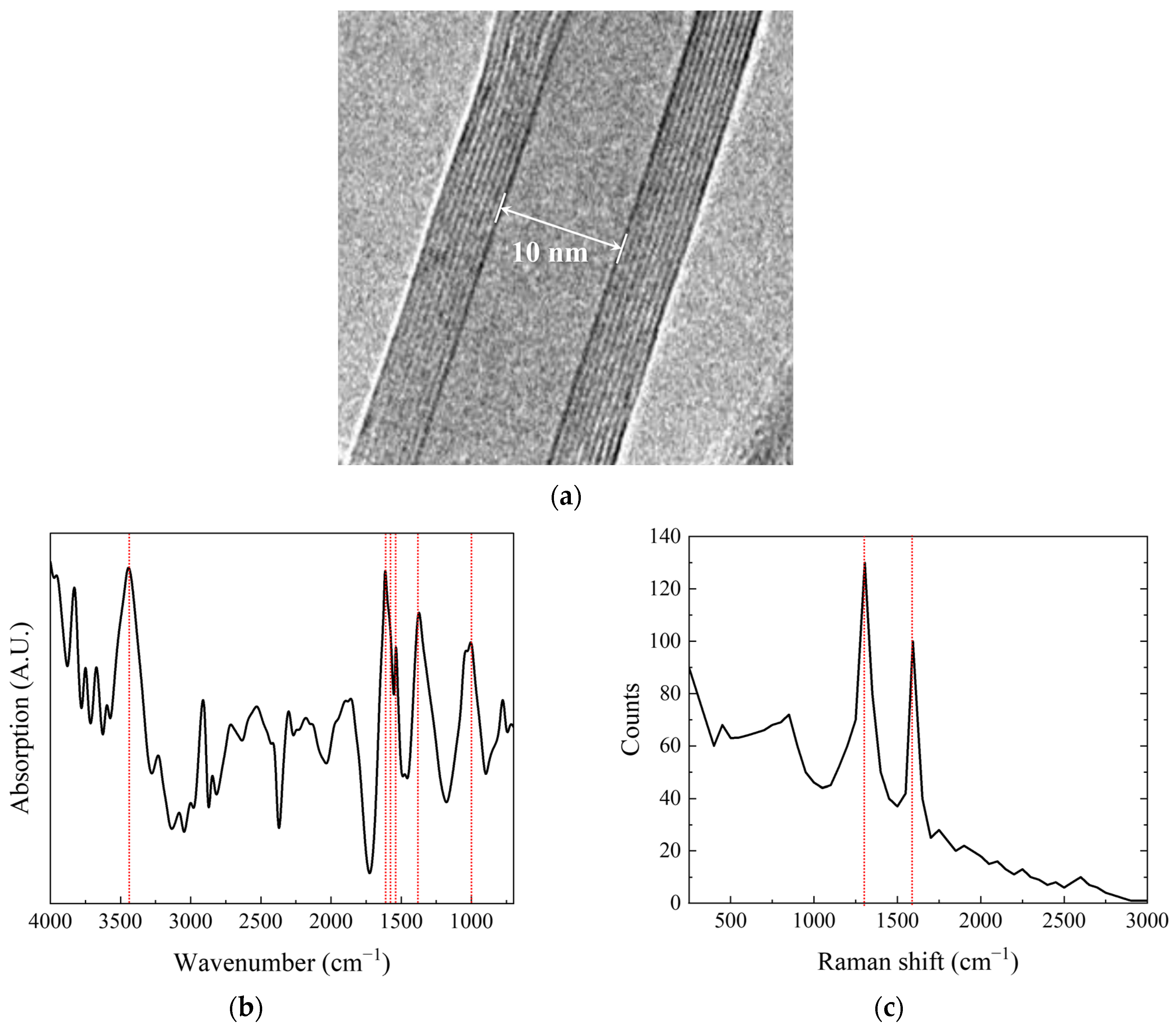
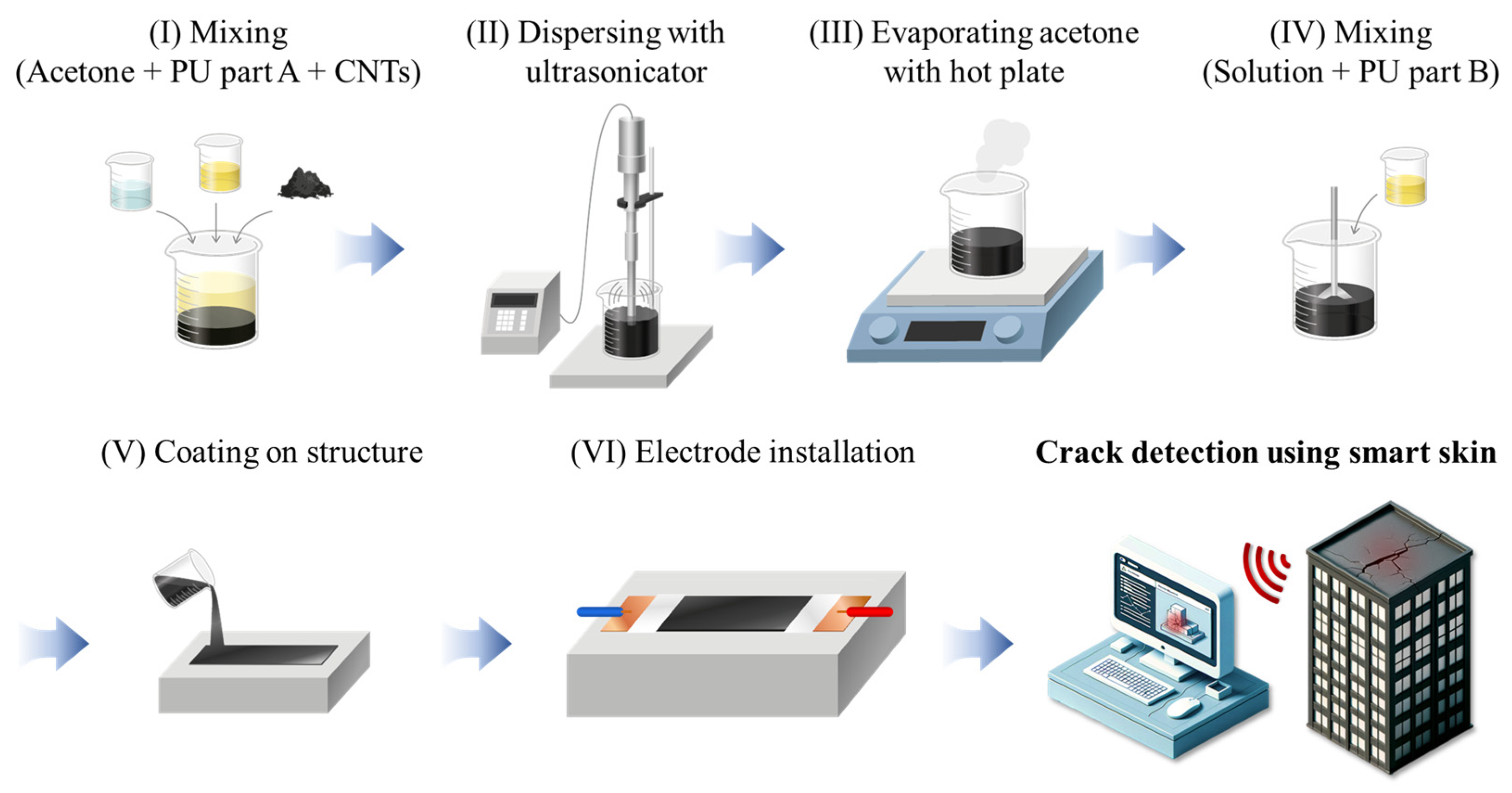
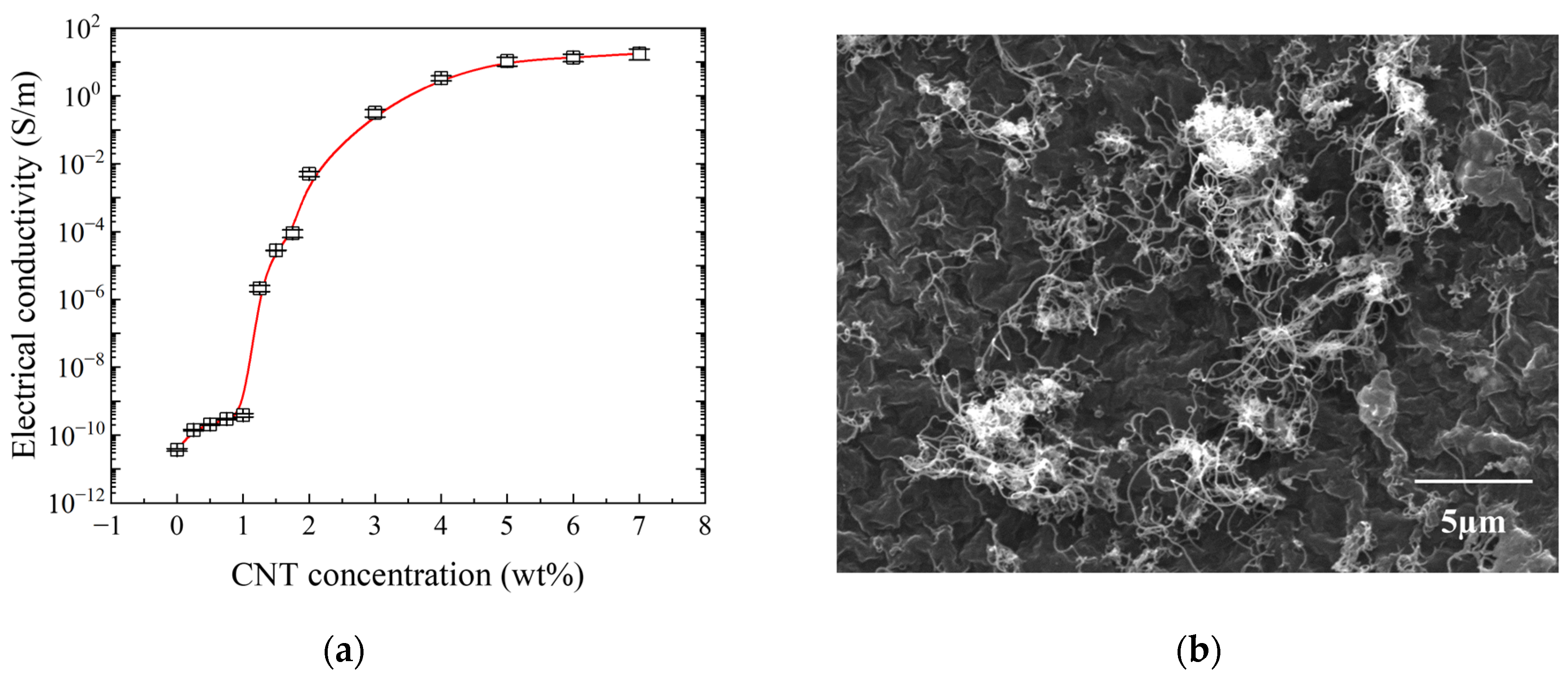
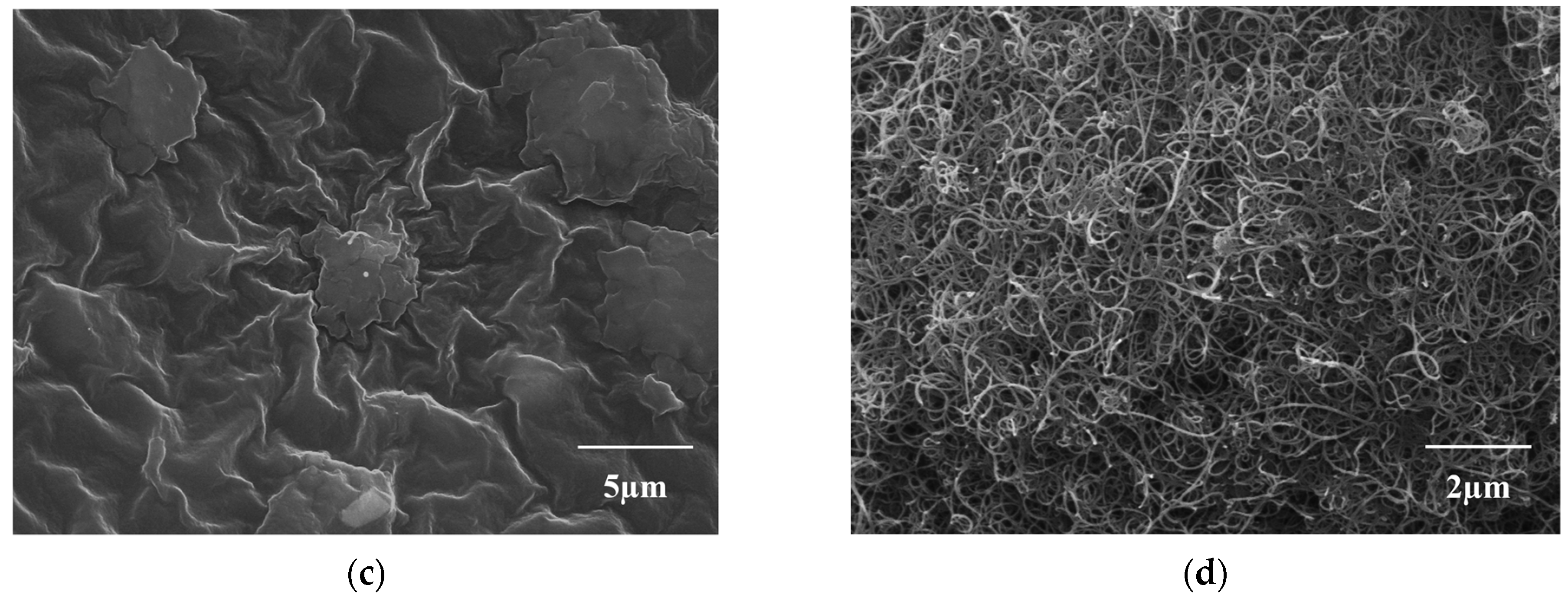
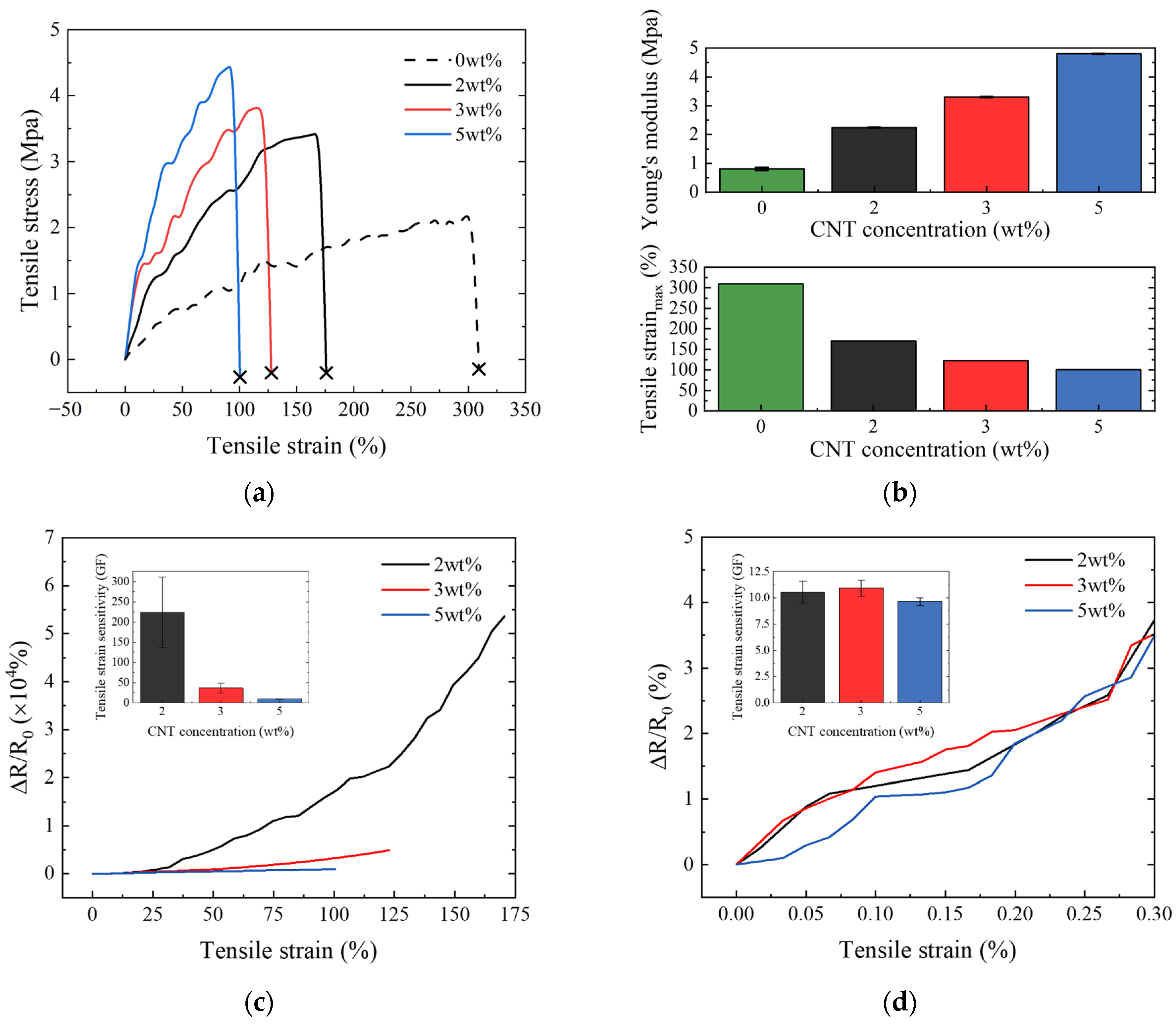


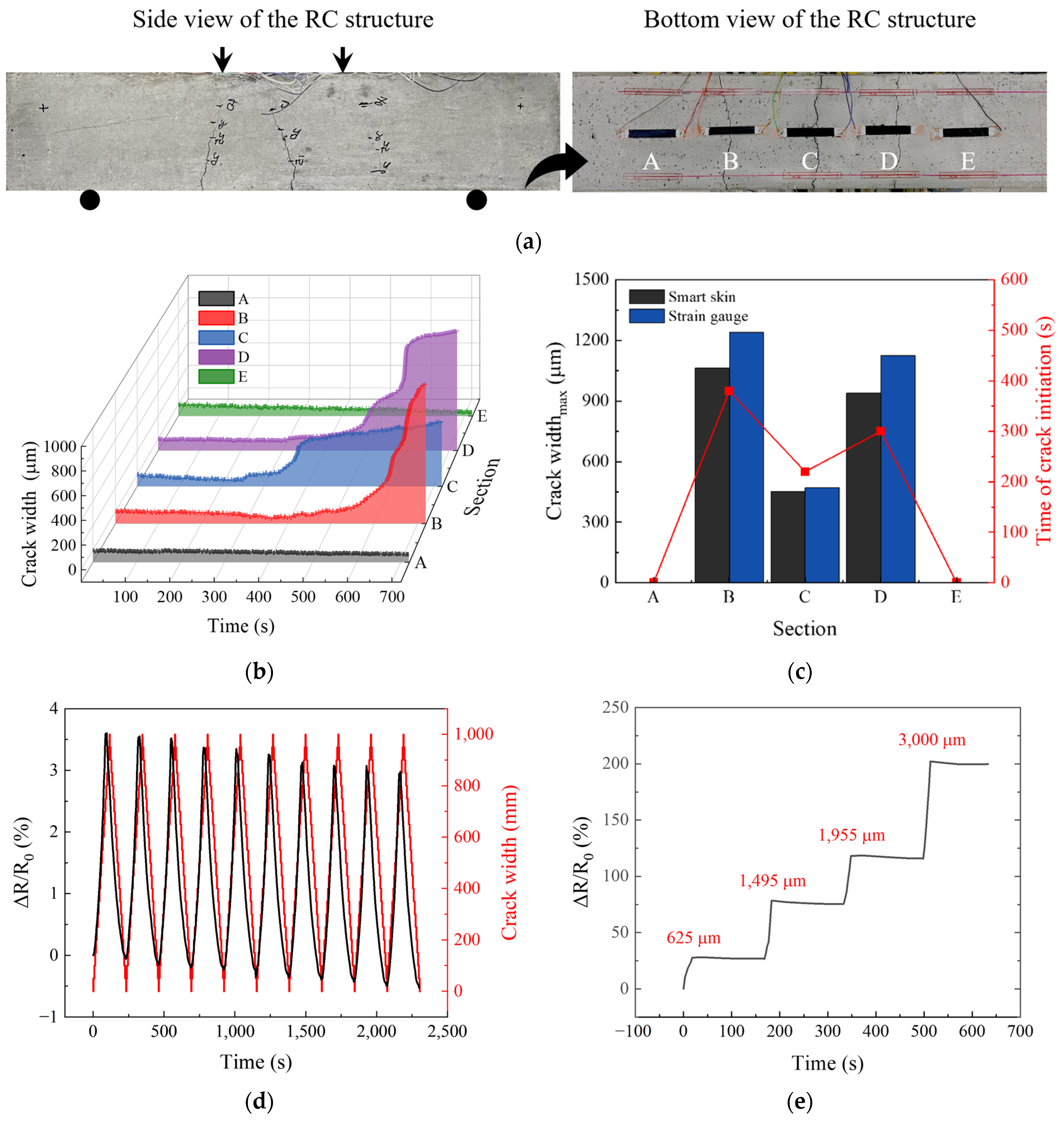
| CNT Concentration (wt%) | Full-Range Strain | Fracture Strain | Metal-Type Strain Gauge Sensitivity | ||
|---|---|---|---|---|---|
| Sensitivity | Error Range | Sensitivity | Error Range | ||
| 2 | 224.0 | ±87.0 | 10.5 | ±1.0 | 2.0–3.2 |
| 3 | 36.5 | ±11.8 | 10.9 | ±0.8 | |
| 5 | 9.8 | ±0.9 | 9.6 | ±0.4 | |
| Section | Correlation Coefficient (r) |
|---|---|
| A | 0.90 |
| B | 0.93 |
| C | 0.99 |
| D | 0.94 |
| E | 0.90 |
| Scale of Correlation Coefficient (r) | Value |
|---|---|
| 0 < r ≤ 0.19 | Very low correlation |
| 0.20 < r ≤ 0.39 | Low correlation |
| 0.40 < r ≤ 0.59 | Moderate correlation |
| 0.60 < r ≤ 0.79 | High correlation |
| 0.80 < r ≤ 1.00 | Very high correlation |
Disclaimer/Publisher’s Note: The statements, opinions and data contained in all publications are solely those of the individual author(s) and contributor(s) and not of MDPI and/or the editor(s). MDPI and/or the editor(s) disclaim responsibility for any injury to people or property resulting from any ideas, methods, instructions or products referred to in the content. |
© 2024 by the authors. Licensee MDPI, Basel, Switzerland. This article is an open access article distributed under the terms and conditions of the Creative Commons Attribution (CC BY) license (https://creativecommons.org/licenses/by/4.0/).
Share and Cite
Jung, Y.-J.; Jang, S.-H. Crack Detection of Reinforced Concrete Structure Using Smart Skin. Nanomaterials 2024, 14, 632. https://doi.org/10.3390/nano14070632
Jung Y-J, Jang S-H. Crack Detection of Reinforced Concrete Structure Using Smart Skin. Nanomaterials. 2024; 14(7):632. https://doi.org/10.3390/nano14070632
Chicago/Turabian StyleJung, Yu-Jin, and Sung-Hwan Jang. 2024. "Crack Detection of Reinforced Concrete Structure Using Smart Skin" Nanomaterials 14, no. 7: 632. https://doi.org/10.3390/nano14070632






